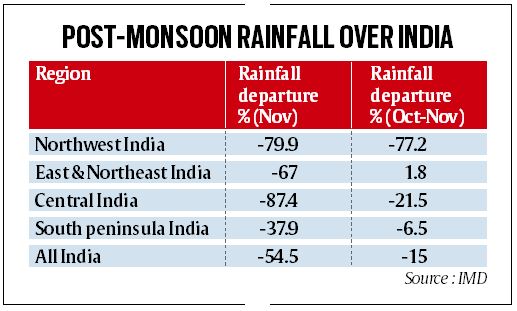Second warmest November in India since 1901: IMD
This warming trend has continued since the post-monsoon season in October and could contribute to making 2024 the warmest year ever on record, globally.
 According to meteorologists, there were two main reasons for the above normal temperatures over India. (PTI file photo)
According to meteorologists, there were two main reasons for the above normal temperatures over India. (PTI file photo)India experienced its second warmest November in 123 years, the India Meteorological Department (IMD) said on Monday.
This warming trend has continued since the post-monsoon season in October, and could contribute to making 2024 the warmest year ever on record, globally.
The average monthly maximum temperature recorded over the country was 29.37 degrees Celsius, 0.62 degrees above normal. The average monthly minimum temperatures, too, were high last month, with a deviation of 1.05 degrees above the normal mark of 15.86 degrees.
According to meteorologists, there were two main reasons for the above normal temperatures in India : the lack of strong western disturbances affecting the plains of northwest India, and lack of cyclonic disturbances (low pressure systems or likewise) — both of which kept the rainfall activity at its lowest across the country.
In November, there were three western disturbances — the east-ward propagating wind streams that cause snow or rain along its path — that passed over the region. In addition, there were only two low pressure systems that developed in the Bay of Bengal, of which one intensified into Cyclone Fengal. Whereas, climatologically, November is one of the most favourable months in the post-monsoon season for the development of cyclonic circulations like low pressures or more intense systems that cause rainfall along its path of movement.

“As there were only two cyclonic disturbances, of which one was feeble, southern peninsular India remained largely dry for most days of November. All the three western disturbances crossed through much over higher latitudes than Jammu and Kashmir, so it did not have much impact on India. So, the plains of north and northwest India did not receive much rainfall,” said Mrutyunjay Mohapatra, director general, IMD.
Northwest India received 2.4mm, which was minus 79.9 per cent from normal. Likewise, south peninsular India, some areas which benefit from the northeast monsoon, suffered a rainfall deficit of 37.9 per cent (see box).
Importantly, the IMD chief noted that the declining rainfall during November was becoming a well-established phenomenon over India over the past two decades. IMD’s rainfall data 2001 – 2024 suggested that the country has received normal or above rainfall during November only during six out of 24 years.
“The rainfall triggered by western disturbances have been found to be on a decline,” said Mohapatra.







